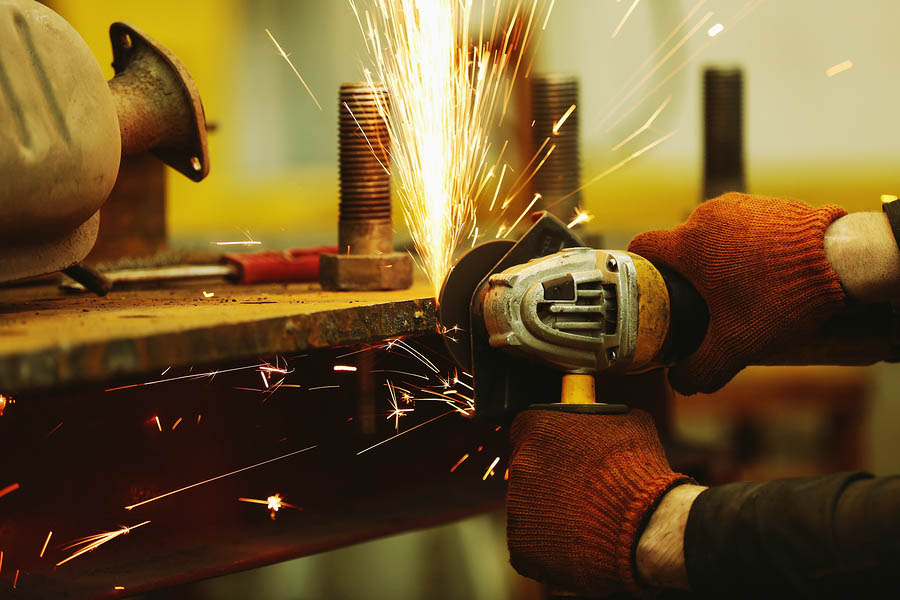Angle Grinder Safety

The angle grinder is one of the most dangerous tools in the workplace. Thus, appropriate angle grinder safety and training on operating procedures are critical for the sake of workers and their families.
The most serious injuries from angle grinders are: lacerations from kickbacks, and lacerations from attachments (such as grinding discs and wheels) that break or shatter to become projectiles.
A Queensland worker died in early 2016 after being struck in the chest by a broken 9-inch angle grinder attachment. As a result, it prompted WorkCover Queensland to issue a safety alert on the use of guards and disc size with angle grinders/
Operators are encouraged to consider the necessity of the task. Examine other possible methods to achieve the end outcome before committing to the use of a grinder tool.
However, if the use of an angle grinder for cutting metal, wood, etc. can’t be avoided, ensure you use it safely.
Purchasing an angle grinder:
Consider safety features first. A dead-man switch (automatic cut-off) is a life-saving function. Also suggested are adjustable handle for left and right-handed operators, vibration-reducing handle, anti-kickback clutch and noise-reducing discs.
Nine inch angle grinders have a higher risk of injury due the increased power and size of the unit. Hence, some work sites in Australia to ban them.
The workspace:
It is important to do a risk assessment of the workspace before operating an angle grinder to ensure that hazards have been controlled.
Inform other workers in the area that the angle grinder will be operating. Then, tidy away slip and trip hazards. Also, ensure that there are no flammable substances in the area. Lastly, ensure that the workspace is well-ventilated to prevent dust and vapour from becoming breathing hazards.
The workpiece should be well-secured and supported so that the operator can work comfortably, preferably at waist height. Never operate an angle grinder between your legs while sitting on the floor.
The disc:
Choosing the wrong disc for the angle grinder is a major contributing factor in accidents.
A disc that is too large for an angle grinder will not be manufactured to support the higher speeds of the smaller grinder. Therefore, there is an increased probability of the disc shattering. Furthermore, the central disc hole will likely be larger than the spindle flange. This increases the risk of the disc becoming unbalanced and shattering and comes with potentially deadly consequences.
When picking the right disc, keep in mind the following:
- Always use the right disc for the task: a grinding disc for grinding, a cutting disc for cutting.
- Always use the appropriate disc for the material being worked on.
- Only use discs which are made for angle grinders. Never use a multi-cutter blade on an angle grinder unless it has been fitted with full spring loaded guarding.
- Never use discs which are too large or too small for the angle grinder being used.
- The maximum revolutions per minute (RPM) disc speed (marked on the disc) must always be higher than the maximum speed of the angle grinder.
- Always use the correct spindle flange and lock nut for the disc and follow manufacturer instructions for correct fitting.
- Never use discs which are worn, damaged or have decreased in size from use.
- Always remove the plug from the power point before fitting or changing a disc.
Ensure the angle grinder is checked for damage or safety issues before use. This includes ensuring that the handle and guard are both secured firmly in the correct position. The power cord should also be in good condition.
While operating an angle grinder:
It is important that operators are trained under one-on-one supervision in safe practices when using an angle grinder.
Two hands should always be used when operating an angle grinder – one to hold the handle and one to support the weight.
The angle grinder should be allowed to run up to speed before being applied to the job with minimum pressure. This is to ensure that it doesn’t grab and kickback.
Grinding discs should be applied at a 15 to 30 degree angle to the object.
Operators should be careful not to let the angle grinder bump against anything, nor should they stand directly behind the tool.
Angle grinders must have stopped turning completely before they are put down or moved around the workplace.
Operators should take regular breaks to rest their hands and arms.
Personal protective equipment (PPE)
PPE is the critical last line of defence in case things go wrong. Given the dangerous nature of angle grinders, the greatest level of protection should be used. This is according to national training manager of Milwaukee Power Tools, Paul Jones.
“High impact rated wraparound eye protection is a must and in addition a face shield is highly recommended,” he said.
“Class 5 hearing protection should always be worn, regardless of the type of work being done with an angle grinder,” Jones said. Users may also consider wearing both earplugs and earmuffs.
“The noise volume will vary depending on the abrasive accessory that you are using – such as flat disc or a grinding disc – and also the type of material the grinder is being used on”.
Jones also said users should wear high quality Class 5 cut resistant gloves.
“Gloves should be well-fitted and provide good dexterity and the best possible protection against cut or abrasion and heat,” he said. Vibration resistant properties are also of benefit, specially on angle grinders that don’t have Milwaukee’s built in anti-vibration features.
Other PPE Jones recommended when using an angle grinder includes approved safety boots and well-fitting flame-resistant clothing.




































































